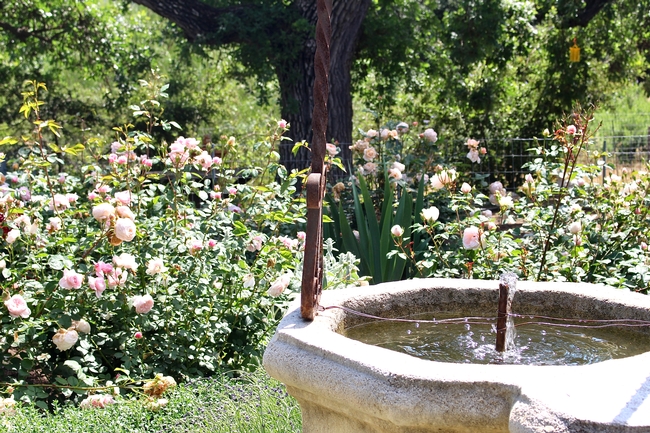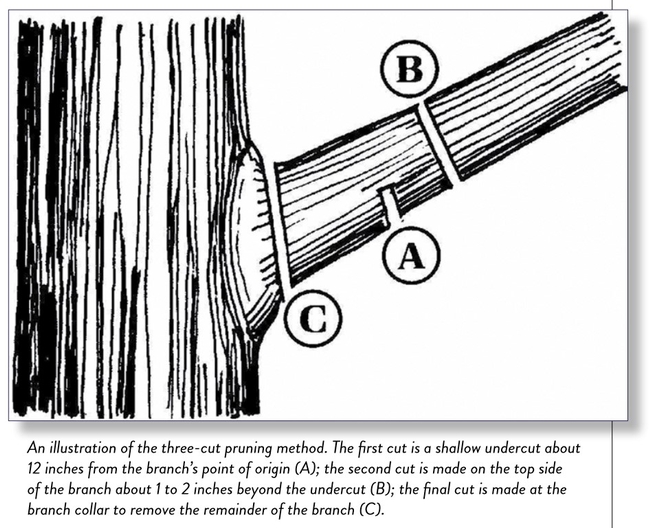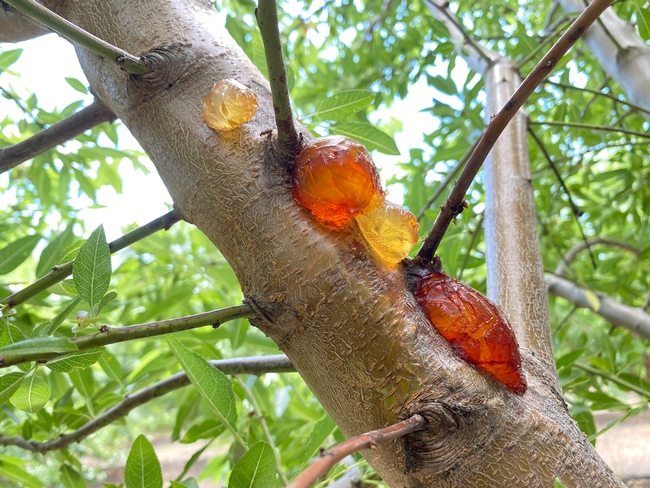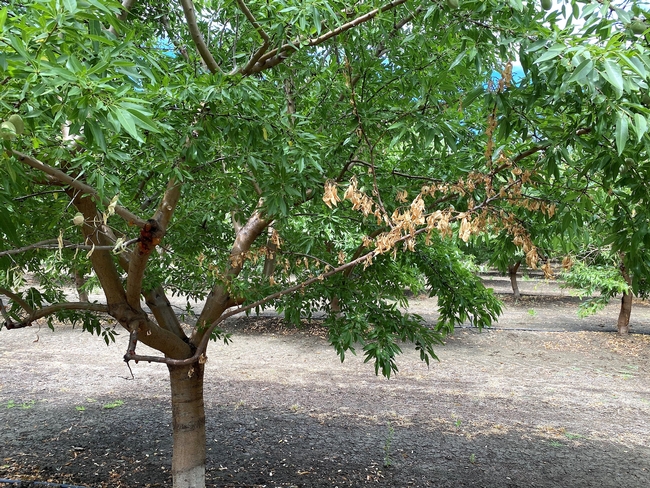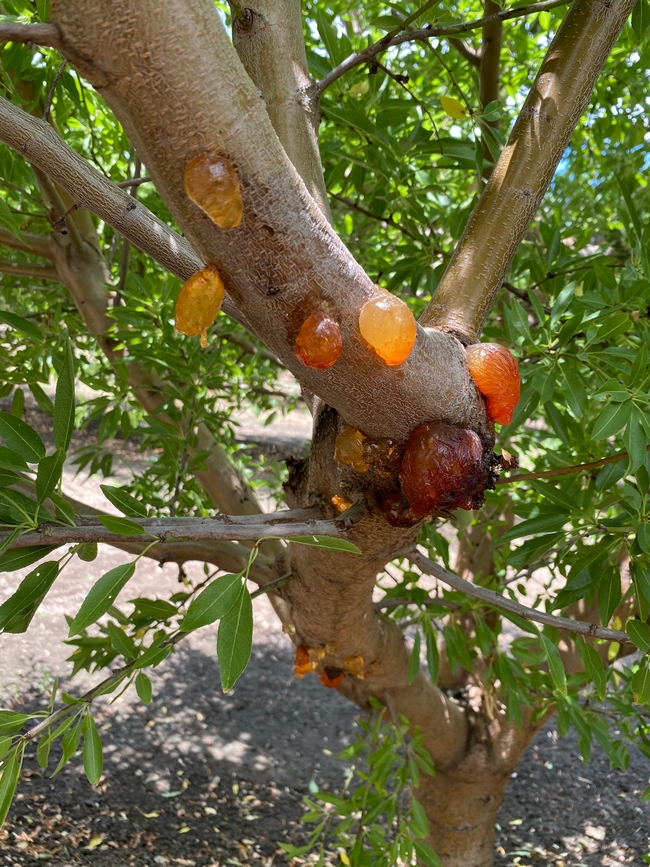Posts Tagged: pruning
Now is NOT the Time to Prune Avocados
When to Prune Avocados and Suggestions of How to Prune
In the past avocados were rarely pruned. In fact, if the trees got very big, growers would stump them down to 3-4 feet and then let them regrow. This would often be a disaster, since the trees rapidly grew to stupendous sizes again. They also might regrow then suddenly collapse, because all that regrowth was coming at the expense of energy being sent to the roots. If the roots were compromised by root rot, they would then not have the energy to fend off the disease. So, by bringing the canopy into balance with a sick root system that was continuing to die and was not being fed by a big canopy, the root death would accelerate and when the canopy and root system became imbalanced again, the whole canopy would collapse, and the tree would die.
Also, this wild regrowth was wild and hard to manage. The adage of “prune avocado trees cautiously” was heard round the avocado community and as a result many growers would not do anything. The trees growing larger and larger and larger with the fruiting canopy going higher and higher and higher and picking costs and liability going up. Tree thinning was practiced, where every other tree would be removed so that light could penetrate into the orchard, encouraging more fruit production and slowing tree growth. But they would still grow, and another thinning would be needed. The original commercial ‘Hass' orchard in Carpinteria started out in 1954 with 140 trees and 40 years later was down to 17 trees and was still productive, but they were monsters that were finally felled by root rot.
Many commercial avocados are now routinely pruned to keep the trees short, so that harvesting costs and other tree maintenance expenses are reduced. Also, more light shines into the trees, so that more fruit is borne on the lower branches. Light or minor pruning can be done any time of year to correct imbalances or limb breakages. However, major or heavy pruning should only be done in the early part of the year from January through April. Fall or early winter pruning can open up the canopy so that it is more prone to frost damage. The closed canopy holds in the heat better.
The major reason not to prune in fall and early winter is that a perennial, evergreen subtropical like avocado goes into a quiescent stage during the fall in preparation for winter cold. The tree does not go dormant like an apple or peach but goes into a metabolic state that can better handle cold. By pruning in the fall, the tree becomes actively metabolic and more prone to frost damage. The tree needs to slow down to better handle the cold.
Avocados flower and bear fruit at stem terminals, so if you give the tree and buzz cut (heading cuts), all the flower terminals will be cut off and there will be no flowering the following year. It also leads to an explosion of water sprouts that result from bud break up and down the branch because the terminal bud which controls the buds lower down have been removed. Naphthalene acetic acid (Tre-Hold) painted on the cut end can be used to restrict some of this wild bud break.
Whenever possible, thinning cuts should be made, where the branch is removed back to a subtending branch. This results in much less wild growth. Also, when there are buds that start growing into water sprouts, they can be nipped back to force lateral growth. These laterals will then slow down the growth of the sprout and the side terminal buds will also be able to grow and transition of flower buds later.
Work in Carol Lovatt's lab at UCR has shown that terminal buds need a certain maturity to flower and the transition from a vegetative bud to a flowering bud occurs sometime in late summer/early fall. If pruning is done in July, there is not enough time for the new buds to mature by August and there will be no flowers from that branch the following spring. New vegetative buds formed on growth from spring will often have enough maturation time to make the transition to flower buds, resulting in flowering the next spring.
Any major pruning done in later spring and summer is also going to require some protection for the remaining scaffolds from sunburn. Get ready to paint the scaffold with dilute latex paint to protect the once protected bark from sunburn damage. This can pretty rapidly kill the underlying cambium within days if it heats up newly exposed wood.
Again, light pruning can be done at any time of the year, but removing terminals is removing potential fruiting wood. Therefore, if heavy pruning is needed, it is best to remove one branch at a time. To reduce the height of a tree, cut out the tallest branch one year, the next tallest branch the following year, and so on until the tree is down to the height required. The process may take three to four years. By reducing the height over several years, the tree is put under less stress, less disease is likely to occur and fruit production is not drastically reduced. Pruning the sides of the tree should be done in the same way. Prune off a side branch that most impinges on a neighboring tree one year, then the next worst offender in the second year, and over the years continue this process until there is light all around the tree.
If pruning creates major open areas in the tree to sunlight where there once was shade, the exposed branches should be painted with white latex paint diluted with water so that it can be sprayed on. It needs to be white enough that it can reflect sunlight and avoid heat damage that can cause sunburn. Sunburn can utterly destroy all the work that has been done.
If the trees are really monsters, the only real alternative is to bring the whole tree down. But not stumping, rather scaffolding where much of the structure is maintained. This is where the tree is brought down to as high a height as is convenient and safe. By cutting the tree to a height of 8 feet or so, there is not so much rank regrowth because a greater portion of the tree is retained. Also, many times there are leafy branches that remain that will flower and fruit and slow the wild regrowth. Water sprouts that form should be headed back to force lateral growth that encourages stems that will flower, which will also slow the wild regrowth.
And one last warning. Do not. Do not. Do not. Got it? Prune sick trees. If the roots are compromised, the regrowth is going to be hard on the roots. Get the trees perked up with one of the phosphite products so that they are ready to go through this process. You may have to wait a couple years to start the pruning process until the trees are in shape for the rigors.
In summary: Late winter to early spring is the sweet spot for pruning your avocado trees. This timing is key because it sidesteps the risk of cold damage and aligns with the tree's natural flowering cycle. Pruning too late can lead to sunburned branches and a reduced fruit set the following year.
Image: Don't make cuts like this. Those stubs or going to create a royal mess of new, wild growth.

avocado pruning stub 1
Lawn-pocalypse! Surviving Drought
Ah, summer! The season of sunburns, pool parties, and… lawn droughts. If your once lush, green carpet now looks like a crunchy brown doormat, you're not alone. Let's dive into why your yard is staging a dramatic death scene and what you can do to...

Bermuda grass and weeds overtaking drought stressed turf grass.
Pruning Roses and Cultivating Beauty
Pruning roses is not just a chore; it's an important practice for nurturing vibrant, healthy roses and fostering the beauty of your garden. In California, where the climate is favorable for growing roses, understanding the significance of pruning is key to achieving thriving and healthy roses.
Why Prune?
Pruning isn't merely about maintaining a tidy appearance; it's about promoting the overall well-being of your roses:
- Annual pruning stimulates plant and shoot growth, leading to larger blooms and a more robust structure.
- Removing dead, damaged, or diseased canes minimizes the risk of fungal infections and pest infestations, fostering plant health.
- Thinning out dense growth improves air circulation within the plant, reducing the likelihood of fungal diseases like powdery mildew and black spot.
- Shaping the plant through pruning enhances its visual appeal, creating a more attractive landscape.
When to Prune
Timing is important when it comes to pruning roses. In California, where winters are mild, the ideal time for pruning is typically between late winter and early spring. Pruning during dormancy allows the plant to focus its energy on new growth when spring arrives.
How to Prune
Pruning may seem daunting, but with the right approach, it becomes a manageable task:
- If the plant is dormant (recommended), remove all remaining leaves.
- Use sharp, clean pruning shears and loppers to make precise cuts, minimizing damage to the plant.
- Trim back old growth by about one-third to improve visibility and encourage new growth. Remove dead, diseased, or crossing canes to maintain a healthy structure.
- Make pruning cuts approximately ¼-1/2” above an outward-facing bud. Pruning cuts should be at a 45-degree angle, sloping away from the outward-facing bud.
- Create an open, vase-like shape by removing canes from the center of the plant. This promotes airflow and sunlight penetration, which is essential for plant health.
- Clear away debris and old leaves to prevent disease spread. Consider applying insecticidal soap or horticultural oil during dormancy to control pests.
Conclusion
Pruning roses is a fundamental aspect of rose care that should not be overlooked. By understanding the importance of pruning and following basic pruning principles, you can nurture thriving roses that add beauty and vitality to your garden year after year. For more details on growing roses and pruning timelines for your area contact your local UC Master Gardener Program.
Wise Words on Pruning
From Tim Spann, Spann Ag Research & Consulting
Use Sharp Tools in order to make Clean Cuts
Follow 3-Cut Method for larger branches
Whitewash with more extensive pruning
Watch the Weather
And Don't Apply Pruning Paint
Pictured: 3-Cut Method

pruning
Almond growers should prepare for possibility of unusual disease outbreak
Wet winter, El Niño create favorable conditions for aerial Phytophthora pathogen
With heavy rains in the forecast amid strengthening El Niño conditions, almond growers should be on the lookout for a rare disease that can cause severe damage to their orchards, according to Florent Trouillas, a University of California Cooperative Extension specialist in fruit and nut pathology.
Phytophthora, soilborne microorganisms dubbed “water molds” because of their dependence on water, typically cause root and crown rot at the base of trees. But a few aerial Phytophthora can travel upwards and infect the higher parts of the tree. One species – Phytophthora syringae – is drawing special attention due to an unprecedented outbreak last winter, fueled by the atmospheric rivers that lashed California.
“It was found statewide – meaning in every almond-producing county – and disease incidence in orchards ranged from 10% of the trees infected to 75%,” said Trouillas, a UC Davis plant pathologist whose lab is based at UC Agriculture and Natural Resources' Kearney Agricultural Research and Extension Center in Parlier.
Trouillas and his colleagues, UC Davis graduate student Alejandro Hernandez and UC Riverside plant pathology professor Jim Adaskaveg, recently published a detailed online article describing the pathogen, which can infect a range of crops but mainly impacts almonds in California.
Although it doesn't kill the tree, the disease causes branch dieback that requires significant additional work and expense for almond growers. In 2022, almonds were the state's fourth-highest valued commodity, at $3.52 billion.
During last year's aerial Phytophthora outbreak, researchers also observed a new and troubling phenomenon: P. syringae, historically known to attack the cuts caused by pruning, was directly infecting the young shoots on almond trees – without any wounds.
“This was really the first time we had seen widespread evidence of infection on the twigs,” Trouillas said.
Although generally rare, outbreaks of P. syringae have been traditionally associated with wet El Niño years, according to Trouillas – and recent and persistent rain across the state should have growers on high alert.
Prune in dry weather, monitor, mitigate if necessary
While almond growers tend to prune during the downtime of winter, they should keep an eye on the forecast and aim for a 10- to 14-day window of dry weather to perform those tasks, whether training young trees or maintaining the established ones.
“If growers were to prune around a rain event – before, during or shortly after – this increases the likelihood of infection because this pathogen moves around with water,” Trouillas explained.
Researchers speculate that P. syringae, normally found in the soil, gets carried into the upper parts of a tree through strong winds and heavy rain. Alternatively, harvest processes like shaking and sweeping also produce air movements that may blow the microorganism into the canopy, where it waits for a favorable wet environment. The pathogen then attacks the wounds or young shoots, producing characteristic cankers and gumming.
The patterns and colors of the gum balls are keys to diagnosing an infection of this particular aerial Phytophthora. Starting around bloom time (mid-February), growers should monitor pruning wounds and young shoots on their trees, especially in the canopy, for signs of the disease.
The unique coloration of the gum balls – ranging from gold and amber to dark burgundy to bright red (see photos) – generally indicates P. syringae infection. But growers are urged to contact their local Cooperative Extension advisor for confirmation.
“It is super critical for growers that, whenever they see gumming, not to assume that it is this aerial phytophthora, because there are many other diseases that can cause gumming on the tree,” Trouillas said.
If the diagnosis is confirmed, growers may apply a compound that can mitigate the infection. The plant pathologists' recent writeup describes several curative treatment options, as well as a preventive measure that reduces the amount of pathogen in the soil and thus the likelihood of infection.
For more information on the pathogen's history and biology, as well as various options for disease management, visit the article on Sacramento Valley Orchard Source: https://www.sacvalleyorchards.com/almonds/trunk-soil-diseases/aerial-phytophthora-outbreaks-in-wet-years.

